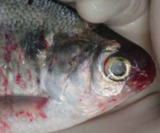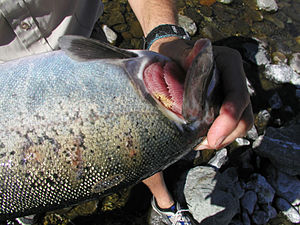- Columnaris
-
Columnaris is a symptom of disease in fish which results from an infection caused by the gram negative, aerobic, rod shaped bacterium Flavobacterium columnare. It was previously known by the names of bacillus columnaris, chondrococcus columnaris, cytophaga columnaris and flexibacter columnaris. The bacteria is ubiquitous in fresh water, and cultured fish reared in ponds or raceways are the primary concern – with disease most prevalent in air temperatures above 12–14⁰C. The disease is highly contagious and the outcome is often fatal. It is not zoonotic.
Contents
Causes
The bacterium usually enters fish through gills, mouth, or small wounds, and is prevalent where high bio-load exists, or where conditions may be stressful due to overcrowding or low dissolved oxygen levels in the water column. The bacteria can persist in water for up to 32 days when the hardness is 50 ppm or more.[1]
Symptoms
An infection will usually first manifest in fish by causing frayed and ragged fins. This is followed by the appearance of ulcerations on the skin, and subsequent epidermal loss, identifiable as white or cloudy fungus-like patches – particularly on the gill filaments. Mucus often also accumulates on the gills, head and dorsal regions. Gills will change colour, either becoming light or dark brown, and may also manifest necrosis. Fish will breathe rapidly and laboriously as a sign of gill damage. Inappetance and lethargy are common, as are mortalities – especially in young fish.
Diagnosis
Bacteria can be isolated from gills, skin and the kidneys. For definitive diagnosis the pathogen should then be cultured on reduced nutrient agar. Inhibiting contaminant growth on the agar by adding antibiotics and keeping the temperature at 37°C should improve culture results. Colonies are small, 3–4 mm in diameter and grow within 24 hours. They are characteristically rhizoid in structure and pale yellow in colour.
Prognosis
Ulcerations develop within 24 to 48 hours. Fatality occurs between 48 to 72 hours if no treatment is pursued; however, at higher temperatures death may occur within hours. Other symptoms may accompany the disease including lethargy, color loss, redness around the infection site, loss of appetite and twitching or rubbing the body against objects.[2]
Treatment
As Flavobacterium columnare is a gram-negative bacteria, fish can be treated with a combination of the antibiotics Furan-2 and Kanamycin administered together. Medicated food containing oxytetracycline is also an effective treatment for internal infections, but resistance is emerging. Potassium permanganate, copper sulphate and hydrogen peroxide can also be applied externally to adult fish and fry but can be toxic at high concentrations. Vaccines can also be given in the face of an outbreak or to prevent disease occurrence.
References
- ^ Aukes, G. Fish disease articles: Columnaris disease. Retrieved 25 July 2007.
- ^ Fournier, Christie. "Cotton Wool Disease (Flexibacter Columnaris)". Nippyfish.net. March 2, 2011. Retrieved March 16, 2011.
See also
External links
- Columnaris Disease, expert reviewed and published by Wikivet at http://en.wikivet.net/Columnaris_Disease, accessed 31/08/2011.
- Fish disease articles: Columnaris disease
- Disease profile: Flexibacter Columnaris
- Columnaris disease
Pathogens - Aeromonas salmonicida
- Columnaris
- Enteric redmouth
- Fin rot
- Fish dropsy
- Flavobacterium
- Hematopoietic necrosis
- Heterosigma akashiwo
- Hole in the head
- Hypodermal and hematopoietic necrosis
- Infectious pancreatic necrosis
- Koi herpes virus
- Novirhabdovirus
- Pfiesteria piscicida
- Photobacterium damselae ssp piscicida
- Salmon anemia
- Streptococcus iniae
- Taura syndrome
- UDN
- VHS
- White spot
- Yellowhead

Parasites - Abergasilus
- Amoebic gill disease
- Carp lice
- Ceratomyxa shasta
- Dactylogyrus vastator
- Diphyllobothrium
- Epizootic ulcerative syndrome
- Flukes
- Glugea
- Gyrodactylus salaris
- Henneguya zschokkei
- Ich (freshwater)
- Ich (marine)
- Kudoa thyrsites
- Lernaeocera branchialis
- Myxobolus cerebralis
- Nanophyetus salmincola
- Salmon lice
- Saprolegnia
- Schistocephalus solidus
- Sea louse
- Sphaerothecum destruens
- Swim bladder disease
- Tetracapsuloides bryosalmonae
- Velvet
Related topics 
This veterinary medicine–related article is a stub. You can help Wikipedia by expanding it.

